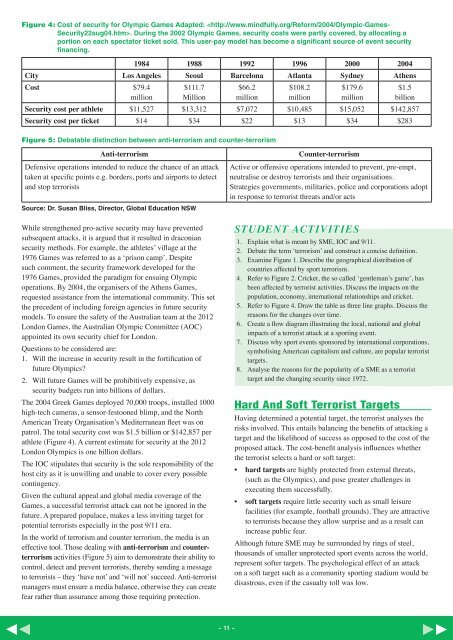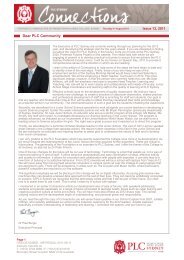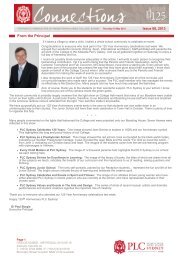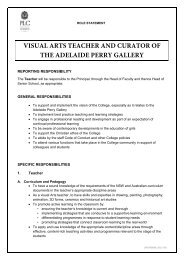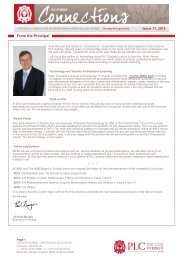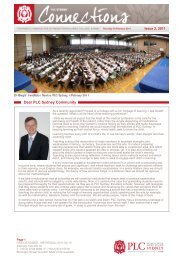Vol 24, No 1, March 2011 - Enable
Vol 24, No 1, March 2011 - Enable
Vol 24, No 1, March 2011 - Enable
Create successful ePaper yourself
Turn your PDF publications into a flip-book with our unique Google optimized e-Paper software.
Figure 4: Cost of security for Olympic Games Adapted: . During the 2002 Olympic Games, security costs were partly covered, by allocating aportion on each spectator ticket sold. This user-pay model has become a significant source of event securityfinancing.1984 1988 1992 1996 2000 2004City Los Angeles Seoul Barcelona Atlanta Sydney AthensCost $79.4million$111.7Million$66.2million$108.2million$179.6million$1.5billionSecurity cost per athlete $11,527 $13,312 $7,072 $10,485 $15,052 $142,857Security cost per ticket $14 $34 $22 $13 $34 $283Figure 5: Debatable distinction between anti-terrorism and counter-terrorismAnti-terrorismDefensive operations intended to reduce the chance of an attacktaken at specific points e.g. borders, ports and airports to detectand stop terroristsSource: Dr. Susan Bliss, Director, Global Education NSWWhile strengthened pro-active security may have preventedsubsequent attacks, it is argued that it resulted in draconiansecurity methods. For example, the athletes’ village at the1976 Games was referred to as a ‘prison camp’. Despitesuch comment, the security framework developed for the1976 Games, provided the paradigm for ensuing Olympicoperations. By 2004, the organisers of the Athens Games,requested assistance from the international community. This setthe precedent of including foreign agencies in future securitymodels. To ensure the safety of the Australian team at the 2012London Games, the Australian Olympic Committee (AOC)appointed its own security chief for London.Questions to be considered are:1. Will the increase in security result in the fortification offuture Olympics?2. Will future Games will be prohibitively expensive, assecurity budgets run into billions of dollars.The 2004 Greek Games deployed 70,000 troops, installed 1000high-tech cameras, a sensor-festooned blimp, and the <strong>No</strong>rthAmerican Treaty Organisation’s Mediterranean fleet was onpatrol. The total security cost was $1.5 billion or $142,857 perathlete (Figure 4). A current estimate for security at the 2012London Olympics is one billion dollars.The IOC stipulates that security is the sole responsibility of thehost city as it is unwilling and unable to cover every possiblecontingency.Given the cultural appeal and global media coverage of theGames, a successful terrorist attack can not be ignored in thefuture. A prepared populace, makes a less inviting target forpotential terrorists especially in the post 9/11 era.In the world of terrorism and counter terrorism, the media is aneffective tool. Those dealing with anti-terrorism and counterterrorismactivities (Figure 5) aim to demonstrate their ability tocontrol, detect and prevent terrorists, thereby sending a messageto terrorists – they ‘have not’ and ‘will not’ succeed. Anti-terroristmanagers must ensure a media balance, otherwise they can createfear rather than assurance among those requiring protection.Counter-terrorismActive or offensive operations intended to prevent, pre-empt,neutralise or destroy terrorists and their organisations.Strategies governments, militaries, police and corporations adoptin response to terrorist threats and/or actsSTUDENT ACTIVITIES1. Explain what is meant by SME, IOC and 9/11.2. Debate the term ‘terrorism’ and construct a concise definition.3. Examine Figure 1. Describe the geographical distribution ofcountries affected by sport terrorism.4. Refer to Figure 2. Cricket, the so called ‘gentleman’s game’, hasbeen affected by terrorist activities. Discuss the impacts on thepopulation, economy, international relationships and cricket.5. Refer to Figure 4. Draw the table as three line graphs. Discuss thereasons for the changes over time.6. Create a flow diagram illustrating the local, national and globalimpacts of a terrorist attack at a sporting event.7. Discuss why sport events sponsored by international corporations,symbolising American capitalism and culture, are popular terroristtargets.8. Analyse the reasons for the popularity of a SME as a terroristtarget and the changing security since 1972.Hard And Soft Terrorist TargetsHaving determined a potential target, the terrorist analyses therisks involved. This entails balancing the benefits of attacking atarget and the likelihood of success as opposed to the cost of theproposed attack. The cost-benefit analysis influences whetherthe terrorist selects a hard or soft target:• hard targets are highly protected from external threats,(such as the Olympics), and pose greater challenges inexecuting them successfully.• soft targets require little security such as small leisurefacilities (for example, football grounds). They are attractiveto terrorists because they allow surprise and as a result canincrease public fear.Although future SME may be surrounded by rings of steel,thousands of smaller unprotected sport events across the world,represent softer targets. The psychological effect of an attackon a soft target such as a community sporting stadium would bedisastrous, even if the casualty toll was low.~ 11 ~


